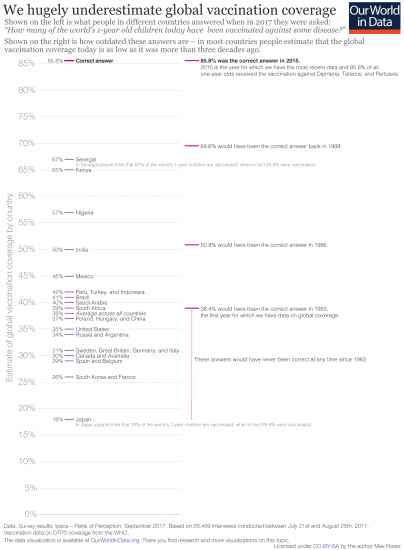We have had an entry on vaccination for many years, but it was never as complete as I wanted it to be.
This year we changed this. Vaccination researcher Dr Samantha Vanderslott joined for this project and over the last months we have brought together the research to give a global long-term perspective on where the world stands in its way to fight infectious disease and provide immunization.
In the fight against vaccine-preventable diseases we are much, much further ahead than most people realize. Look at the chart below. It shows the survey responses that people gave when they were asked “How many of the world’s 1-year old children today have been vaccinated against some disease?”. The correct answer is 85.8%; this is the share of 1-year olds that received the combination vaccine that protects against Diphtheria, Tetanus, and Pertussis (whooping cough).
But in all countries in which people were surveyed people were much too pessimistic about the global coverage. Americans think that only 35% of the world’s children are vaccinated, the true coverage is 50 percentage points higher. In Japan people were even more pessimistic and thought that only 18% were vaccinated. As we have seen on other questions on global development we again see that people in poorer countries have a more accurate view of the world: in Kenya and Senegal people thought that vaccines reach around two thirds of all children in the world, but even these highest estimates are 20 percentage points too low.
Shown on the right in the same graphic is an indication of how outdated these answers are. Most people’s worldview is outdated by more than three decades. Most estimate that global vaccination coverage today is as low as it was in the 1980s or even earlier. (In the entry you find the data on global vaccination coverage over time.)
This survey result is sad of course. But it is good news for Samantha and me. It shows that up-to-date information on vaccination is very much needed: Here it is.
